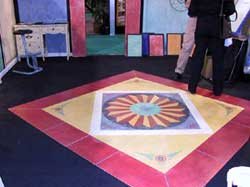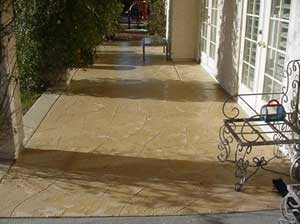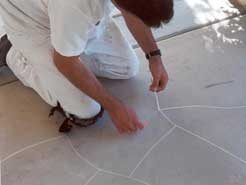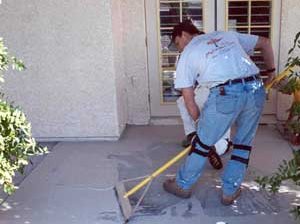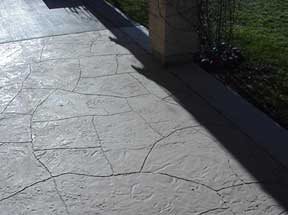- Staining Concrete
- Stamped Concrete
- Concrete Overlays
- Concrete Resurfacing
- Concrete Polishing
- Concrete Dyes
- Colored Concrete
- Indoor Concrete
- Concrete Floors
- Concrete Countertops
- Garage Floor Coatings
- Furniture, Sinks, Fire Bowls
- Basement Floors
- Outdoor Concrete
- Concrete Patios
- Concrete Driveways
- Concrete Pool Decks
- Outdoor Kitchens & Counters
- Outdoor Fireplace
- Concrete Walkways
- Concrete Pavers
- Concrete Walls
- Repair & Maintenance
- Foundation Repair
- Concrete Crack Repair
- Concrete Sealers
- Building with Concrete
- Concrete Homes
- Concrete Basements
- Decorative Concrete
- Fire Resistant
Barth's takes faux finishing to a new level
With over 15 years of experience in decorative painting, master craftsman Barth White began dabbling in faux finishing long before the technique became all the rage. From beginnings as a wallpaper contractor in the 1970s, he branched out into the faux finishing and decorative painting of walls in the 1980s. He soon became one of the premier faux and decorative painting contractors in the Las Vegas area, and in 1995 he opened his own decorative painting studio, Barth's Faux Finishing.
Barth has developed a reputation for exquisite workmanship. He has worked his magic at such renowned hotels and casinos as Caesar's Palace, the Bellagio Casino & Resort, the Hilton Casino, the Mirage, and many others. His residential work has taken him from California to the Caribbean and around the globe to the Orient. About a year ago, Barth took his artistic skills to another level - the faux finishing of concrete floors. And he's discovered that he can use many of the same techniques, products, and tools on these surfaces that he’s been using for years to transform vertical surfaces into works of art.
"It's such a great marriage to be able to do the walls and floors at the same time, using the same finish in different color values or different finishes in complementary colors," he says.
Barth admits, though, that his recent experiences in the faux finishing of concrete floors aren't his first. Back in the 1980s, he experimented with applying paints and penetrating stains to concrete floors, but was not pleased with the results. He couldn't achieve the intensity of color he wanted using stains, and the painted finishes chipped and scratched easily. Now, thanks to recent advancements in decorative products for concrete, he's able to achieve spectacular results with less effort.
"The decorative finishing of concrete floors has really come a long way in the past few years. The products available today are more affordable and easier to use. You can now order your materials out of buckets, just as you would for walls," he explains.
In the past year, Barth has completed several residential floors using his faux finishing techniques. Next, he plans to move on to larger commercial projects.
A palette of plasters and acrylics
One of Barth's preferred materials for faux finishing of concrete floors is a lime-based Venetian plaster called Marmorino. "Marmorino is one of the lime-based plasters that works just as well on floors as it does on walls. It provides a beautiful, hard finish that doesn't chip easily," he says, adding that until five years ago, these plasters, most of which come from Europe, were difficult to find in this country. Now many U.S. suppliers of decorative paints and finishes carry them.
Marmorino is a classic polished stucco material originating from ancient times. Its ingredients include marble flour, fine sand, and long-season lime. It can be applied by trowel to virtually any properly prepared surface to impart the look of polished stone. And because it’s lime-based, like concrete, it allows floor surfaces to breathe. Marmorino can also be tinted virtually any shade with natural tints or oxide colorants.
A lot goes into the makeup of these Venetian plasters, Barth explains. "The look they offer varies with the type of sand and lime used, the quality of the lime, and the shape of the sand particles. One of Barth’s products uses lime that comes out of the same quarry that Michelangelo got his lime from when working on the Sistine Chapel."
Barth has also been experimenting with some of the new acrylic paints on the market and is pleased with the results. "Their adhesion to concrete is wonderful, and the durability is fabulous," he says. He has also had success applying glazes over acrylic base coats to create a more dramatic effect.
To make it easier for contractors and artisans to obtain these and many other faux finishing products for walls and floors, Barth now distributes them through his company's online Faux SuperStore.
Learning faux techniquesBecause faux finishing is an art, the procedures Barth uses vary depending on the effects he's trying to achieve and whether he’s using a plaster or acrylic. "There are so many possibilities for achieving different textures, depths, and colors," he emphasizes.
When finishing concrete floors with acrylics or Marmorino plasters, he often applies several layers of varying colors to simulate the rich, multihued appearance of marble, stone, or a mosaic. "Most of the time, we just draw the pattern out on the floor. If we want to add grout lines, we tape them in and float the plasters on top," he explains. When the tape is removed, the lines are revealed.
The design dictates the number of colors and layers used. "How many layers we apply depends on how intricate we want to get," says Barth. "You can apply each color individually and mask each one off where desired before applying the next layer."
Each layer of plaster is hand-troweled with stainless steel or hard plastic trowels. "Troweling breaks the sand in the lime-based plaster so it lays flat and you get a nice sheen," Barth explains.
To demonstrate the myriad effects that can be achieved with various products, Barth's studio in Las Vegas conducts three levels of faux finishing classes, from beginner to advanced. Soon he plans to offer classes in the decorative finishing of concrete floors.
Faux finishing tips
Although each project is unique, Barth adheres to the following basic rules for most jobs:
Start with a clean substrate - You can apply faux finishes to both new or existing concrete floors, but existing surfaces require adequate surface preparation to attain good adhesion. Many of the newer acrylics have a lot of "tooth" to them, so etching or blasting of surfaces is typically unnecessary.
Minimize the potential for cracking - Although these finishes are highly durable, they can crack if you get a lot of movement or cracking of the concrete substrate. To minimize the potential for cracking in new floor installations, be sure to use adequate slab reinforcement and space joints properly. However, cracks in the finish aren’t always an eyesore. "If you use just one color, a crack is more obvious. But if you have a mottled finish using several colors and you want an aged look, cracks can be desirable," Barth says.
Don’t be afraid to experiment - The products Barth uses offer virtually unlimited color options, and applying several layers of different colors can produce stunning results. "For a mottled surface, we use no more than three colors. If we’re doing a marbleized finish, we may use a lot of colors. With a bit of experimentation, we can give designers exactly the look they want," he says.
Protect your work - Last but certainly not least, it's important to protect your faux finish with a clear acrylic topcoat. In high-traffic areas or for commercial installations, Barth recommends re-applying this protective topcoat annually.
For more information:
Barth's Faux Finishing
3520 Coleman St.
Las Vegas, Nevada 89032
(702) 631-5959
www.faux.com
Anne Balogh writes feature articles each month for The Concrete Network (www.concretenetwork.com). She is a freelance writer based in Glen Ellyn, Ill., and a former editor of Concrete Construction magazine.
